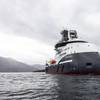Robert Allan Designed RAmparts 3300 ASD Tug for China
The Cao Gang 26 is a new RAmparts 3300 ASD tug designed by Robert Allan Ltd., constructed at JiangSu Zhenjiang Shipyard (Group) Co. Ltd. in China and delivered to the Owner, Cao Fei Dian Port in Northern China in November 2016.
Particulars of the Cao Gang 26 are as follows:
Length overall, moulded: 33.00 m
Beam, moulded: 12.20 m
Depth, moulded (hull): 5.40 m
Draft, Summer Load: 4.75 m (above bottom of drive)
The tug was designed and constructed to China Classification Society (CCS) requirements with the following notation:
★ CSAD, Tug, Coastal Service, Ice Class B, ★ CSMD BRC
Major tank capacities are as follows:
Fuel Oil: 70.0 m3
Potable Water: 36.2 m3
Water ballast tanks: 120.6 m3
On trials, the vessel met or exceeded all performance expectations, producing the following:
Bollard Pull, astern: 60.5 tonnes
Free running speed, ahead:13.5 knots
The vessel has been outfitted to the highest standards for a maximum crew complement of 14. The Master’s and Chief Engineer’s cabins are located on the main deck, and two six-person cabins are located on the lower accommodation deck. Also included are common W/C’s on the main and lower accommodation decks.
The deck machinery consists of a ship assist hawser winch and a pair of independent anchor windlasses on the bow.
The wheelhouse is designed for with a forward control station providing maximum visibility all-round but especially to forward and aft deck working areas.
Main propulsion for each tug comprises a pair of Yanmar 6EY26W diesel engines, each rated 1,920 kW at 750 rpm, and each driving a Rolls-Royce, US205 fixed pitch Z-drive unit, in ASD configuration.
The electrical plant comprises two (2) identical diesel gen-sets, each with a power output of 120 ekW.
Ship-handling fenders at the bow consist of one row of 800 x 400 cylindrical fender at the main deck level, with 300 mm W fenders between the main deck and the knuckle. A 300 x 300 hollow “D” fender provides protection at the main and foc’sle deck sheer lines, and 300 mm “W” block type fendering is used at the stern.












